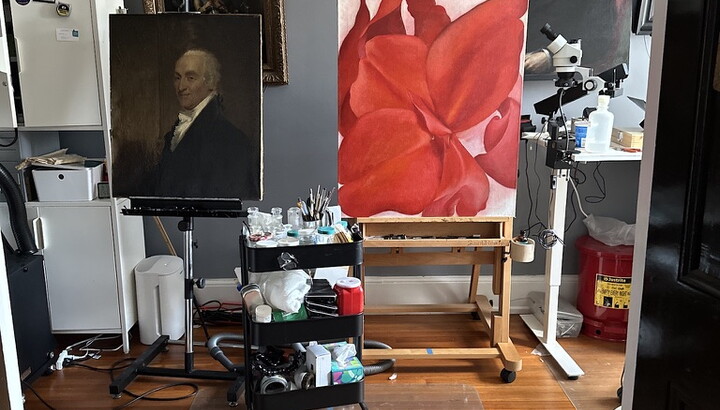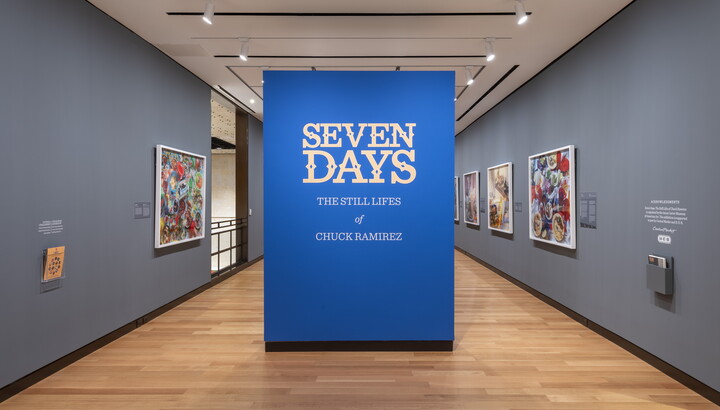The Carter Blog
Carter ARTicles
Our museum body
Jul 17, 2024
Brooklyn-based artist Jean Shin is the next contemporary artist to activate the Museum’s first-floor sloping gallery with a new site-specific installation, Jean Shin: The Museum Body. For this installation, Shin created a textile-based portrait of the Carter from clothing items donated by Carter employees. Separating the fabric from its seams, Shin shaped these elements into a large-scale immersive installation that activates the gallery walls and ceiling. Including clothing items from curators, conservators, educators, and other staff, this installation represents the collective work of the people who enable a museum to function. We talked with some of the Carter staff that make up our museum body and asked them about the clothing items they chose to donate to the installation.
Maggie Adler
Former Curator of Paintings, Sculpture, and Works on Paper and curator of Jean Shin: The Museum Body
There came a point a few years ago when a lot of curators nationwide started buying versatile patterned garments from a company called Zuri. A colleague of mine at the National Gallery of Art calls this brand “The Curator’s Uniform.” Only once have I shown up to a conference wearing the same Zuri as another curator. That same colleague, Carter alum Sarah Cash, bought this one for herself and didn’t like the pattern. She sent it to me as a gift, and I have worn it proudly. The thing is, curators are photographed a lot as they give exhibition tours, talks, and presentations. On the blog, the members magazine, and the Museum’s social media, I started to notice that show after show, I’d be featured making the same hand gestures in the same dress. I thought: “Time to retire that one.” I figured the exhibition opening for Emancipation: The Unfinished Project of Liberation when it traveled to Tulane University would be its last hurrah. But coming back from New Orleans, I had to turn around to say goodbye to my mom, who had suffered a stroke. As I tossed items in and out of my carry-on in deep distress, I had one levelheaded thought: “I better keep something nice in my bag to wear for a likely eulogy.” My parents were passionate about the arts and helping artists. I knew that the garment I hoped to send to Jean, my curatorial uniform, would become something else in her hands, living beyond my time at the Museum and standing for something transcendent. So, I am honored to preserve my mom’s legacy and my curatorial time at the Carter by incorporating this well-worn garment into the fabric of The Museum Body.
Greg Bahr
Senior Preparator and Preparations Lab Manager
The two main reasons I donated this shirt was first, it has been worn many times to work at the Museum. At one point it got latex paint on it and became my work shirt for painting. The second reason was that I felt that the colorful plaid pattern would contribute to the overall aesthetic of the installation. To me, this shirt is not very significant, it is just a shirt that is now in its third phase of its existence. However, this article of clothing was somewhat of a placeholder for some of my work memories. I had the shirt before I worked at the Carter over two decades ago. It has accumulated characteristics over time that remind me of the past, and now it has found another purpose.
Marci Driggers
Head of Collections Registration
When I heard we were going to be hosting a Jean Shin installation, I ran to my closet to try and find something that might capture someone’s eye visually. I chose a silk, black-and-white striped shirt I used to wear to work a lot. As a registrar, my “uniform” has evolved over time. When I first started my career, a more formal attire was required. Thankfully, over the years things have become a lot more casual. While I still like to dress up occasionally, the days of high heels and silk shirts don’t come around as often! I use repurposed fabric in my own embroidery work, so the idea that something that used to be a part of my wardrobe will now live on makes me really happy.
Matthew Jones
Control Room Officer
My attire that I donated to the installation represents my insistence on projecting professionalism. Though I am restricted on what I am allowed to wear, black slacks and a gray button-down, small tweaks can be worked in: suspenders, suit pants instead of khakis, ties, vests, and other small additions to make my uniform as professional as I can. I want to be treated with respect and dignity, and that begins with how I carry and present myself. It is difficult as the role I fill is a modest one, but the endeavor is worth it if it encourages me to stand just a little straighter. I am an artist, a museum professional, an educator, and a guardian, and this is the uniform I have made for myself to carry me through to the next day.
Jara Lang
Development Stewardship Coordinator
Wearing something fun never fails to elevate my mood. For example, quirky shoes are a favorite way to amp up an otherwise bland outfit. As a Visitor Experience Associate (VEA), where I worked for many years, quirky outfits were not really an option. You see, the VEA is often the first person a visitor meets when they come to the Carter. Thus, and rightfully, a VEA’s appearance is held to a high standard. The uniform for VEAs was, at that time, “all black clothing.” Wearing black, for me, became monotonous over the course of several years. So, I worked hard to find creative and unique ways to “spice up” the all-black dress code without “coloring too far outside the lines.” This blouse, with its black-on-black flower print, was the perfect way to add a little jazz to my wardrobe. After I left Visitor Experience for the Development Department, I swore off black clothing for months! I knew it would be my tribute to the installation as soon as I saw the call for donations! The blouse had been a personal statement—a “mood-lifting expression of individuality”—and is now a true artifact of my museum life at the Carter.
Isaura Lopez Sanchez
Digital Gallery Teaching Specialist
I have always loved art in all its forms, but I do not have the calling to create art. I find that an artist's process is always a beautiful part of the final product, and to be included in Jean Shin's creation was an opportunity I wanted to explore. As a Latina, I have not always felt welcomed or represented in all art spaces. My intention is that the dress I donated for this project gives me an opportunity to change that. I am a Nicaraguan American born in Nicaragua but raised in Los Angeles. One thing that crosses boundaries and borders is fashion. It was ingrained in my family and culture to dress up to celebrate special life events and look presentable. I chose a black dress with small red roses because when I think of red roses I think of femininity and womanhood. The rose is seen as the preferred flower of the Virgin, another important symbol in my culture and one that, as progressive as I'd like to think I am, I continue to come back to for spiritual support. I see this dress as a walking tribute to my person and culture.
Prickles
Family Programs Jackalope
I jumped at the chance to give my little old bandana to Jean Shin because I heard she was going to do something big and exciting with it. I love to lend a paw whenever my friends need help with a project! My blue bandana has lots of memories all tied up in it. I wore it every day for almost four years, after all! I wore my bandana to teach virtual family programs during the pandemic, lead silly circle times during Spring Break, and make friends with artists like Willie Cole, Christina Fernandez, Letitia Huckaby, Sandy Rodriguez, and Sarah Sense! Every time I met someone new, or played games with children, or said goodbye to old friends, I wore my bandana. Plus, it kept me from getting carrot juice in my fur at lunch time! I am so proud of everything I do at the Carter, helping families and young children have fun and feel comfortable in the galleries. Wearing this bandana helped me remember that I am part of a big, wonderful team! We help each other, encourage each other, and give each other a big pat on the back when we need it. I live far away from my family in the West Texas desert, so I appreciate the reminder that I have people here who care about me.
Arianna Tejada
Curatorial Assistant and gatherer of clothing donations for Jean Shin’s installation
I had only been working at the Carter as Curatorial Assistant for about two weeks when I was tasked with being the gatherer of the staff’s clothing donations for Jean Shin’s work. I was excited and a little nervous as I had the crucial responsibility of safekeeping and keeping track of materials for a major exhibition at the Carter. Armed with my sharpie, paper bags, and large cardboard box, I was ready to take on this duty. I did not realize it at the time, but as the weeks had gone by, this experience developed into a special opportunity to meet the Carter staff as the new face in curatorial. People from different departments came up to my desk, introduced themselves to me with a smile on their face, and handed over something significant to them and their work. More than just an introduction, I got to see a sliver of everyone’s personality in just a piece of clothing. I am thrilled to see all the staffs’ donations commemorated in Jean’s work and to know that I played a small part in its undertaking.
Andrew Walker
Executive Director
Often in the role of Executive Director, I have had to create a style for my many public appearances. The diversity of conventional ties became a quest for me. For many years, I had a Carter-branded tie that I would wear as a show of institutional support. This tie is part of my contribution to Jean Shin’s installation. Over time, however, I became bored with the array of straight neckties and one day decided to wear a bowtie, one of which is also part of this installation. I clearly remember a conversation with a patron at the Museum who often sported a bowtie himself. He said that no matter the circumstance, each tie of the bowtie ended up looking a bit different. Some were precise in their edges and creases and others had a messy profile. I was intrigued and began my research on YouTube to find the right method to get the perfect knot. The mastery was indeed elusive, but the bowtie helped to bring some pizzazz to my daily attire. Colorful and fanciful, the addition gave me joy and, often, made patrons and guests to the Carter smile. Over time, my colleagues at other museums would make certain that I had the bowtie of their institutions in my wardrobe. Artful attire became part of my style and demonstrated that a simple piece of cloth could become a personal brand. Lately, I have traded the bowtie for a bolo tie, embracing the tradition of the American West. It is amazing how, when in front of so many people as part of my work, one item of clothing can become a source of conversation and, well, identity. I wonder what my next chapter in neckwear will bring.
Jean Shin: The Museum Body is on view through June 30, 2025.











